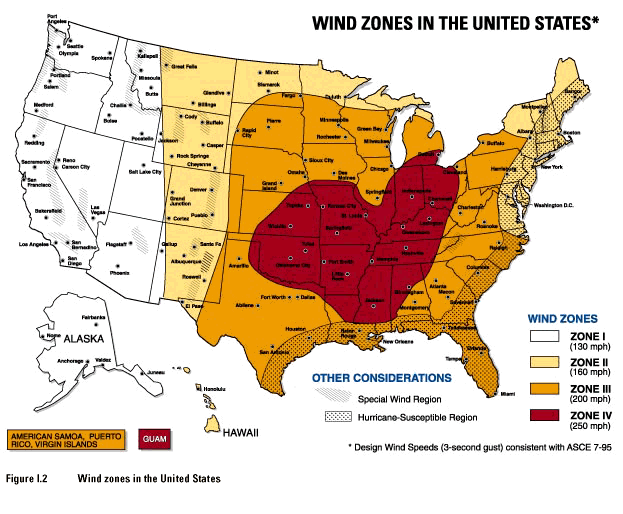How Wind Ratings Affect Building Codes
Wind factors into the design of all construction, including metal buildings. As we enter the peak of the hurricane season running from mid-August to mid-September, let’s examine the meaning of wind zones and their effect on construction.
Wind Zones and Construction
 Regardless of the building system, wind-proof structures do not exist. No structure is likely to survive a direct hit by an EF5 tornado with wind speeds over 200 m.p.h.
Regardless of the building system, wind-proof structures do not exist. No structure is likely to survive a direct hit by an EF5 tornado with wind speeds over 200 m.p.h.
However, pre-engineered steel buildings are designed to withstand expected wind extremes based on collected historical weather data for the specific location.
Certain areas of the U.S. experience stronger winds than other areas. The FEMA (Federal Emergency Management Agency) map below shows the Wind Zones in the U.S. These wind zones supply engineers and building code officials with the probable top wind speeds a building might face in a given location.
Note that these zones are not based on sustained wind speeds, but on a 3-second gust of wind.
Exposure and Metal Buildings
The terrain surrounding a building also affects the wind’s force on the structure. A building right on a coastal beach has little protection from gales sweeping across the water’s surface. However, trees, hills, or other buildings surrounding a structure may act as windbreaks, lessening the force of straight-line winds.
To account for these differences in location, the International Building Code developed these definitions to determine the “exposure” of a structure:
- Exposure A: An outdated designation, no longer applied in construction by the American Society of Civil Engineers (ASCE)
- Exposure B: Urban and suburban or wooded areas with many buildings placed close together, such as a residential neighborhood.
- Exposure C: Open, rural areas with scattered buildings less than 30’ tall, or other barriers, including shorelines of hurricane-prone areas, farmlands, and grasslands.
- Exposure D: Flat expansions of land with zero obstructions, such as sparsely populated plains, salt flats, and the like. Also includes buildings constructed near large inland waterways that extend a mile or more from the shore, such as the Great Lakes.
Facing Mother Nature at Her Worst
Using the criteria above, steel designers and engineers create metal wind-resistant buildings to meet all current building codes for the specific area.
Be sure to check out our next blog, which details the specific wind-resistant features of RHINO metal buildings.
When the winds start to howl, you will be glad you chose a strong, durable RHINO steel building. For details and a free quote on a wind resistant building, call RHINO today at 940.383.9566.

